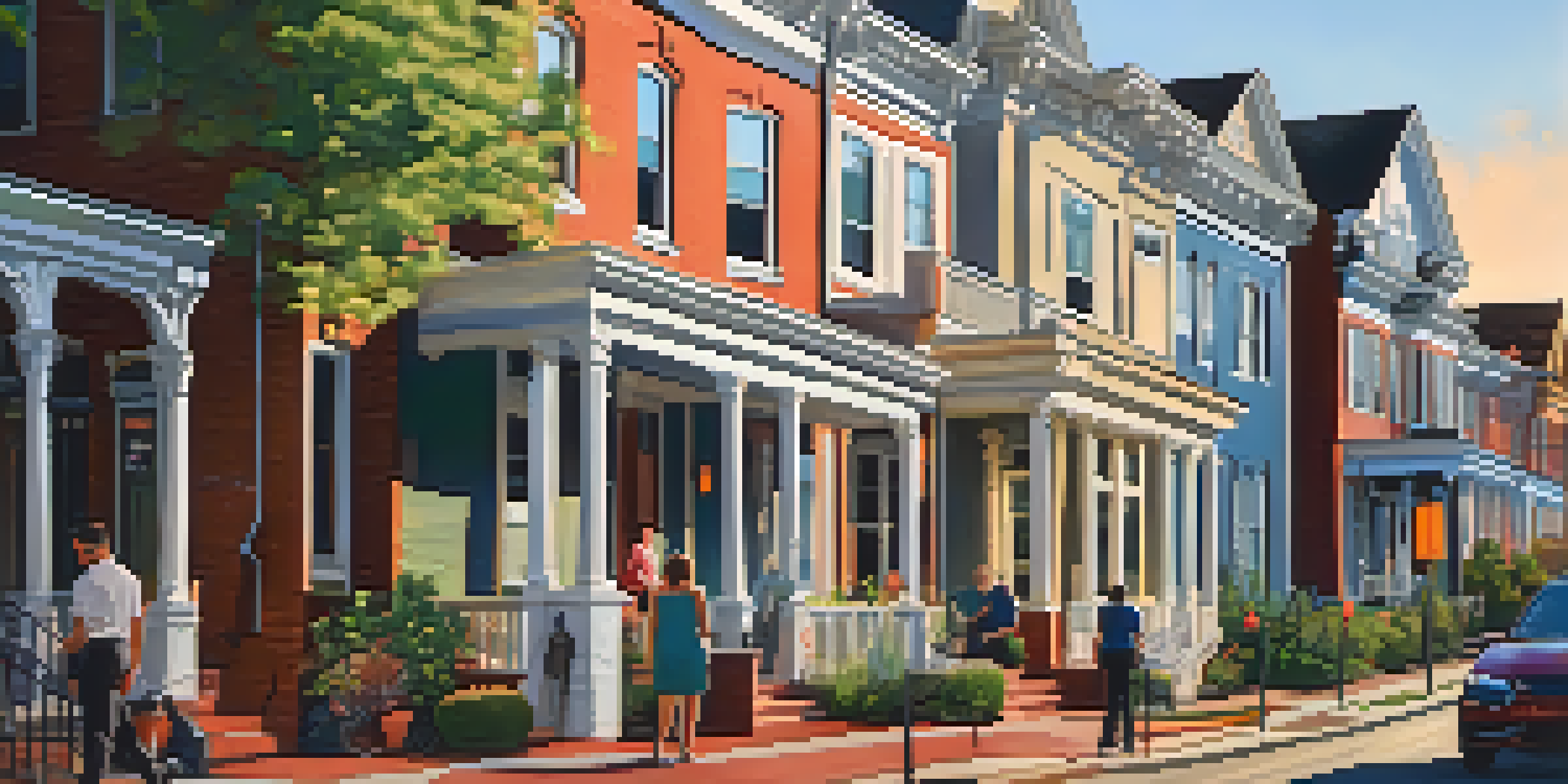Gentrification Trends in Charlotte: Balancing Growth and Equity

Understanding Gentrification: A Double-Edged Sword
Gentrification is often seen as a catalyst for urban renewal, breathing new life into neighborhoods. However, this transformation can lead to rising rents and displacement of long-time residents. In Charlotte, as new businesses and developments emerge, the question arises: who benefits from this growth? Understanding both sides of gentrification is crucial for creating balanced urban policies.
Gentrification is not inherently negative; it’s the management of its impacts that determines the overall outcome.
For instance, areas like NoDa and South End have seen significant investment, attracting a younger demographic. While this influx can enhance local economies, it can also alienate existing communities. It's essential to recognize that gentrification is not inherently negative; it’s the management of its impacts that determines the overall outcome.
As Charlotte continues to evolve, the challenge lies in fostering development while ensuring that all residents can thrive. This balancing act calls for thoughtful dialogue among city planners, developers, and community members to create inclusive policies.
Economic Growth vs. Community Displacement in Charlotte
Charlotte's economy is booming, with job opportunities and investments pouring in from various sectors. However, this economic growth is not uniform; it often disproportionately benefits newcomers at the expense of established residents. The rising cost of living can push out families who have called these neighborhoods home for generations, leading to a loss of cultural heritage.

Take, for example, the historic neighborhoods like Dilworth, where the charm of old homes is increasingly threatened by new developments. As property values soar, long-time residents find it challenging to keep up with taxes and housing costs. The stark contrast between economic development and community stability raises important questions about fairness and inclusion.
Balancing Growth and Equity
Charlotte's gentrification challenges highlight the need for policies that promote both urban development and community stability.
To address these issues, city leaders must look beyond short-term gains and consider the long-term health of communities. Policies that protect affordable housing and support local businesses can help mitigate the adverse effects of gentrification.
The Role of Policy in Managing Gentrification
Effective policy can be a powerful tool in managing the complexities of gentrification. In Charlotte, various initiatives aim to strike a balance between growth and equity. For instance, inclusionary zoning policies encourage developers to set aside a portion of new units as affordable housing.
Effective policy can be a powerful tool in managing the complexities of gentrification.
Moreover, community land trusts have emerged as a viable solution, allowing neighborhoods to retain ownership of land and prevent displacement. These models not only maintain affordability but also empower local residents to have a stake in their community’s future. When people feel invested in their neighborhoods, they are more likely to participate in the decision-making process.
However, implementing these policies requires collaboration among city officials, developers, and residents. Engaging the community in planning discussions can lead to innovative solutions that respect the needs of both new and existing residents.
Community Voices: The Heart of Gentrification Discussions
At the core of gentrification discussions are the voices of the communities affected. Residents’ experiences and concerns must be front and center in any conversation about urban development. In Charlotte, grassroots organizations are advocating for the rights of displaced families, ensuring their stories are heard and valued.
These organizations often host town hall meetings and forums, creating platforms for dialogue between residents and policymakers. By sharing personal narratives, community members highlight the real-life impacts of gentrification, pushing for empathetic approaches. Their efforts remind us that behind every statistic, there are families facing uncertainty and loss.
Community Voices Matter
Engaging residents in discussions about gentrification ensures their experiences shape equitable urban policies.
The power of community advocacy cannot be underestimated. As Charlotte navigates its growth, listening to its residents will be essential in creating a more equitable city for all.
Case Studies: Successful Gentrification Management
Several cities across the U.S. have implemented successful strategies to manage gentrification while promoting equitable growth. For instance, San Francisco’s affordable housing initiatives have become a model for other urban areas. By requiring developers to include affordable units in new projects, the city has managed to preserve some level of affordability amidst rapid growth.
Similarly, cities like Portland have embraced community engagement in their urban planning processes. By prioritizing input from local residents, they have been able to address concerns proactively and foster inclusive development. These case studies offer valuable lessons for Charlotte as it grapples with its own gentrification challenges.
Implementing such strategies requires a commitment to collaboration among stakeholders. By learning from the successes of others, Charlotte can pave a path that balances growth with community needs.
Education and Awareness: Building a Gentrification Toolkit
Education is a crucial aspect of addressing gentrification. By equipping residents with knowledge about their rights and resources, cities can empower communities to advocate for themselves. In Charlotte, workshops and informational sessions are becoming more common, helping residents navigate the complexities of housing and displacement.
Additionally, awareness campaigns can inform newcomers about the history and culture of neighborhoods they are moving into. Understanding the roots of a community fosters respect and encourages newcomers to engage positively with existing residents. It’s about building bridges rather than barriers.
Education Empowers Residents
Providing residents with knowledge about their rights and resources can help them advocate against displacement.
Creating a 'gentrification toolkit'—a resource that combines legal information, local history, and community resources—could serve as a beneficial guide for both residents and developers. Such tools can foster understanding and collaboration, ultimately leading to healthier urban ecosystems.
Looking Ahead: The Future of Gentrification in Charlotte
As Charlotte continues to grow, the future of gentrification remains uncertain. The city's trajectory will depend on the choices made by its leaders and residents in the coming years. With ongoing discussions about equity and inclusion, there is an opportunity to forge a path that benefits all.
It’s vital for city planners to remain vigilant about the impacts of development on existing communities. By prioritizing affordable housing and community engagement, Charlotte can set a standard for how urban growth should be managed. This requires a commitment to not just economic progress, but also social responsibility.

The future of gentrification in Charlotte can be a tale of two cities or a model of success. By working together, the city can ensure that growth does not come at the cost of equity, creating a vibrant, inclusive community for everyone.